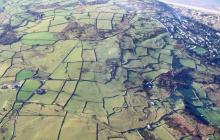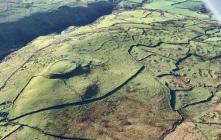Landscapes of Prehistory
Items in this story:
Rare Survivals
It is difficult to appreciate the deep antiquity of the Welsh landscape, yet at intervals along the coast and in upland areas, where land is generally more marginal and less cultivated, fragile traces of ancient settlements and fields survive – fragments of the houses, farms and trackways laid out by Iron Age people or by Bronze Age or Neolithic people before them.
Such remains are vulnerable to ploughing, land drainage and stone clearance, particularly in the fertile, well-drained lowlands of south and central Wales. However, early farming landscapes can be well preserved in parts of the uplands, on islands like Skomer and Ramsey, and on heath-grown coastal headlands in Pembrokeshire, Gwynedd and Anglesey. Welsh examples rank among the finest in western Europe.
Dyffryn Ardudwy
The Cors-y-gedol field system, near Dyffryn Ardudwy in Gwynedd, is particularly impressive. Although the ancient fields here have long been known to archaeologists, only during the 1980s and 1990s did sustained programmes of ground survey, aerial reconnaissance and air-photo mapping by Snowdonia National Park and the Royal Commission begin to reveal their complexity and quality. The major oval and rectangular field enclosures and roundhouse foundations probably belong to the Iron Age and Romano-British periods. However, Neolithic origins can be postulated for at least part of this farming landscape (something that is rare in Britain), indicated by its association with a chambered tomb.
Burnt mounds also survive in the fields – mounds of fire-cracked stones thought to have been used in communal cooking or bathing, usually of Bronze Age date. Settlement, farming and replanning of these fields continued after they were brought within the Vaughan estate of Cors-y-gedol in the seventeenth century. On the ground the stony, gorse-grown banks are disorientating, but with a map or guide one can seek out substantial foundations of Iron Age roundhouses and walk along an embanked trackway between field plots in the footsteps of countless prehistoric farming families.
Muriau’r Gwyddelod
Cors-y-gedol is one of the better-researched parts of the Dyffryn Ardudwy coastal strip, but the area has other remarkable survivals, including Muriau’r Gwyddelod (Irishman’s walls), above Harlech. This is a tract of hillside where Romano-British huts and paddocks are divided by sinuous walls from neighbouring homesteads, just a few hundred metres from the sprawling houses of modern Harlech. Other such landscapes no doubt remain to be discovered along footpaths and on open hills across Wales. Each new example provides a tangible and potent link to the prehistoric past.
Story contributed by: RCAHMW


